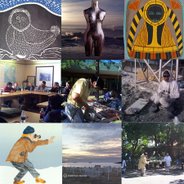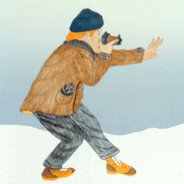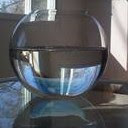Edit in process: Ovilu Tunnillie’s imagery is riveting both in her words and in stone. She accepted an interview with me during a break from her carving in the workshop of the Ottawa School of Art, where visiting Inuit artists have been welcomed for a number of years. She was part of a small delegation of Inuit artists selected to be honoured at the bi-annual Qaggit gathering organised by the Inuit Art Foundation, Ottawa, ON.

Ovilu Tunnillie's work is recognized nationally and internationally for her powerful, innovative approach to carving in stone. She is represented in numerous major galleries and prestigious collections including the National Gallery of Canada and the Ontario Gallery of Art. She is regularly featured in commercial galleries in numerous southern cities including Vancouver where she is a favourite of the respected Marion Scott gallery. There Judy Kardosh has exhibited an almost life size wooden sculpture carved by a British Columbia sculptor of Ovilu Tunnillie wearing a Mother Hubbard. Her work has been the subject of numerous articles and several books. She has become a world traveler. She is respected both as artist and community leader.
Her work involves a relational subject, one capable of using a number of lenses. One of the more demanding tasks for an artist is to relate the parts to the whole. She is able to manipulate entire figures into intricate and complex relations. This is evident in her early work, for example the Fighting Dogs, Hawk Eating Char as well in her self-representations with the qabblunat in Manitoba, her mother, and in my favourite piece, her granddaughter Tye. Tye is the adorable baby tucked into the Ovilu Tunnillie's amaut in the photo accompanying her text in Women Artists from Cape Dorset.
Ovilu Tunnillie's work which spans three decades has included small carvings, even jewelery. Her diminutive size and her small hands, in stark contrast to the size of her sculptures, astonish her many admirers. Her strength is not immediately apparent but she works like an athlete. She even wears a towel slung over her shoulders like an athlete in a workout! She dresses appropriately. She skillfully uses the tools of her trade.
Her practical and humble explanation for why she works large astounded me. Apparently for her there is less cramping and therefore less strain on her hands when she works the larger stones! (She has had several operations on her hands.)
This paradox reflects her work. Her work has been described as subtle and sensual, fresh and feminist. It has also been described as ambiguous, ironic even subversive. Her works turns heads and stops viewers in their tracks. Years ago Marybelle Mitchell, Director of the Inuit Art Foundation and editor of the Inuit Art Quarterly, described her as an artist to watch.
Her work reflects a keen sense of observation complemented by an astounding capacity to retrieve embedded memories in three dimensional detail. This gift of recall is demanding intellectually. When she described the process of sculpting, she emphasizes with her hands the difficult task of thinking it into being first. It takes a great deal of concentration and she does not like to interrupt her work. She carves constantly and she carves big!
In order to fully appreciate how impressive her work is, it is helpful to situate her childhood, youth and early adult years against the backdrop of irreversible structural changes taking place all around her. Ovilu Tunnillie's (b. 1949) childhood on the land was interrupted by the diagnosis of tuberculosis in 1955. Like thousands of Inuit in the 1950s she spent years away from her close knit family, in sanitoria in southern Canada. (By 1956 the largest year-round Inuit community in Canada was in Hamilton at the Mountain Sanatorium where 332 Inuit patients were being treated. There were 1,578 Inuit being treated in Canadian hospitals such as Clearwater Sanitorium, MN, Mountain Sanitorium, Hamilton,ON, Charles Camsell Indian Hospital, Edmonton, AB and Moose Factory, ON in 1953(Grygier 1994:1)! Inuit and Indian girls and women shared and learned new stitches, acquired patterns, language skills (Conversations with Sarah Ekoomiak).
By the time Ovilu Tunnillie made the return trip on the C. D. Howe to Baffin Island, she was ten years old. By the late 1950s most Inuit of her father's generation were still hunting, fishing and gathering. They earned money from casual work such as handymen, cooks or guides and were already dependent on southern manufactured items (Mitchell 1996:117).
She had forgotten much of her homeland and her language. As a mature adult artist she translated into stone her early fears of the strange women she encountered in the south, white women whose faces were hidden behind veils. Her sculpture entitled "This has Touched my Life" (1991-2) depicts four figures, a child, an man wearing a suit and tie and two women wearing veils. This memory was very clear to Ovilu who wondered why these women wore veils. (Inuit Women Artists 1999:223-5). She described one of her favourite sculptures, one she carved five months ago. She vividly portrayed the moment of her return from the southern tuberculosis sanitorium to Kangia, her father Toonoo Toonoo’s camp on Foxe Peninsula. She could describe in minute detail the expression on her baby brother’s face, (Jutai) as he peered at her from her mother’s (Sheojuk’s) amaut. In her year long absence she had become a stranger to this baby whose birth she had witnessed.
In a way Ovilu Tunnilee's work is like a series of autobiographical life scenes, powerful statements of separation and reuniting as experienced by a child and remembered by a mother and grandmother. She traces the strength evident in her work and in her life to these pre-adolescent years where she was pulled between alienation and belonging between Baffin Island and sanitoria in Manitoba, between Inuktitut and English.
Throughout the 1960s when she could accompany her father on his trips by dogsled she was drawn to collecting stones. When she was seventeen she attempted her first carving just to see if she was able. It was unusual for women to carve at that time. It meant working outdoors and it was considered to be men's work. Women, like her own mother, Sheojuk Toonoo, were encouraged to provide drawings for the newly opened Co-op print shop while her father Toonoo Toonoo and other camp members Niviaqsi and Kudjuakjuk made carvings to supplement their earnings. The year that Ovilu returned coincided with the year the opening of a Co-op in the hamlet of Cape Dorset. The first Inuit art print collection was published in 1960. Inuit across the Eastern Arctic were encouraged to carve and draw for an emerging, carefully nurtured southern market.
Tragedy struck in 1969 when her father was shot with a rifle. With Toonoo Toonoo gone the family could no longer live the semi-nomadic lifestyle. They moved permanently to Cape Dorset.
She began carving regularly in 1973. In the 1970s she experimented with making jewelery. She learned to cast bronze. She produced a small bronze casting "Man and Bear" in c.1974-6. She also learned to make lithography prints in the Cape Dorset print shop(1978-9).
A number of factors prevented Inuit across the North from continuing to subsist in a semi-nomadic eco-centric lifestyle moving from hunting camp to fishing camp that Ovilu Tunnillie experienced as a young child. Previously, epidemics of imported diseases had devastating Inuit camps but none were as destructive as TB. Outpost camps lost valuable members to the TB exiles and were forced to move closer to HBC trading posts (Mitchell 1996:119). In the 1950s one-third of the Inuit population was infected with TB. In some communities everyone had TB at one time or another(Grygier 1994:1)! i953 Prime Minister Louis St. Laurent stated: "Apparently we have administered the vast territories of the north in an almost continuing absence of mind. (Parker 1996:32)" The government recognized that it had a responsibility for northern people. The government began to establish about forty permanent administrative centres to provide education, health and economic development services for Inuit (Parker 1996:32). Inuit from hundreds of smaller camps scattered across the north, began to congregate in these hamlets (Mitchell 1996:118). The federal Department of Northern Affairs and Natural Resources was formed in Ottawa. An intergovernmental committee on Eskimo Affairs was reinstated (Crowe 1997:34).By 1954 there was mounting criticism of the Eastern Arctic Division and federal services for Inuit (Grygier 1994:190). In 1953 James Houston flew to Cape Dorset and other outpost camps in his function as Crafts Officer for the Department of Mines and Resources.
It was easier to sell Inuit arts and crafts in the post-DEW line era as there was a greater possibility of more air connections. While the Inuit community was struggled to survive there was a growing interest in things made by Inuit, part of a broader fascination with what was called "authentic primitive art," things made by the indigenous peoples of Africa and the Americas. Long before Alma and James Houston settled in Cape Dorset in 1955 and became active in encouraging carving and
handicrafts, the market for things made by Inuit was already being primed. The Museum of Modern Art in New York bought the first set of Cape Dorset prints. Governor General Vincent Massey gave an Inuit print to Princess Margaret as a wedding present. Things made by Inuit reached a larger population in 1953 when Charles and Peter Gimpel opened an exhibition entitled "Eskimo Carvings" during the Coronation celebrations at their gallery in London, UK (Vorano 2004:9-18). Charles Gimpel had traveled to Canada's far north taking photographs along the way in the 1950s and 1960s long before this became a popular tourist attraction. See Tippett and Gimpel (1994). Their Coronation exhibition caught the attention of international media including Time International, Mayfair, The Observer, The Times. By the time Charles Gimpel and Terry Ryan visited James Houston in Kingait in 1958 Inuit art was already easy to market. By 1957 there was a permanent Museum of Primitive Art established in New York (Errington 1998:, Phillips 2002:46-7).
She not only describes traditional life; she also comments on these experiences in her art. By 1981 when she had a solo exhibition in Montreal she was already producing work that examined vulnerabilities of Inuit in the modern world. A very interesting one is "Thoughts Create Meaning" (c.1980)
The hand represents the grip of drink on Inuit. I thought about the drinks taking grip on Inuit.... This [the head] is the mind. Inuit were given alcohol by the government. The hand which is the symbol of Inuit, is pointing a finger at the government official. No one in particular, but qabllunat (white people). You will notice the man isn't wearing kamiit because the person's white. If I'd meant to depict Inuit as if they had brought it (alcohol), then it would feature an Inuk. I am attempting to depict that the man is thinking: I', attempting to depict that his mind is being affected by this head. This was my thought at the time. I disliked alcohol for what it can do to people. 1991 interview with Odette Leroux.
In the same 1991 interview she discussed, "Woman Passed Out." She described how liquor was brought up from the white people, not from the Inuit. This woman may not mean to be the way she is here. She has had too much alcohol and she has passed out. Statement by artist: "This is a work of aesthetic inspiration and not intended as a social commentary".
Her carvings of Airplane (c.1986), Football player, (1981). She watches football now. Also Seaman, Seawoman and Fish. c.1981 50 cm. This is taleelayu. Ovilu has never seen one. It's from her imagination. She wonders about the inhabitants of the sea: if they had lives like the Inuit. and in 1992 she was director of the West Baffin Island Eskimo Cooperative.
While she does not balk at depicting the everyday life of embodied urban Inuit, she is still intrigued by beings that exist only in the Arctic such as Taleelayao. The fish like Taleelayo are marine beings so she "just included them." One of her personal favourites is "Taleeyalo" (1994) a 68cm high white marble sculpture now in the National Gallery of Canada.
She also likes to carve bird wings spread out very thin. "I Made this with my Hands" 1990 is very much like the theme of Oonark's "My Hands are like Birds" "The hands are the most creative part of us.
"Woman on High Heels", 1987. In 1970s in Montreal on television she saw nude women wearing high heels. This sculpture is of a true white woman. Inuit women hardly ever wear high heels. "Skier" 1993 NGC 30 cm. Skater 1988.
Ovilu Tunnillie is cited as the example of feminism in Inuit art, the argument for placing contemporary Inuit sculpture with contemporary southern artists, an artist who has broken constraints and dissolved stereotypes.
I had brought photos of her work to discuss during our interview. She looked through them and excitedly stopped at the sculpture entitled "Football Player." She exclaimed that there were things she wanted to tell me about this work that she could not say with her limited English.
Ovilu married in 1969. She has adult children and four grandchildren. She is proud of being able to make carvings like a man.
Some additional notes on specific works: (Draft)
Errington, Shelly (1998) The Death of Authentic Primitive Art and Other Tales of Progress.




1 comment:
I heard of an Inuit legend, involving two women who had to leave the community, and unexpectedly did survive. In fact, they returned with important lessons about preserving food.
Can anyone give me a source for this story?
I am trying to locate it for an elderly cousin.
Appreciate any help, I realize this is not the main purpose of the blog.
Post a Comment